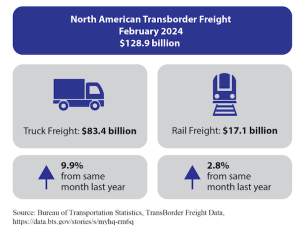Emerging Issues:
• High Hazard Flammable Trains (HHFT): Trains consisting of 20 or more tank cars in a continuous block or trains with 35 total cars loaded with flammable liquids are considered HHFT under U.S. Department of Transportation Regulations. These trains have certain operational and safety requirements. While there are many substances that fall under the flammable liquids definition, crude oil and ethanol were the primary traffic segments the rule was intended to target.
Vinyl chloride is not a flammable liquid – but rather a flammable gas. As such, the HHFT requirements would not apply to the train involved in this incident.
Despite this, federal regulations along with railroad operating procedures focus on ensuring all hazardous material shipments rail companies are compelled by law to carry arrive at their destination without incident. Depending on the type of hazmat, these precautions are often similar or exceed those defined under the highly hazardous flammable train regulations. In the case of vinyl chloride, the tank car requirements exceed those used in a HHFT.
• ECP brakes: The much-discussed ECP rule would not have applied to the NS train that derailed in East Palestine had it been in place. As NTSB Chairwoman Jennifer Homendy noted in a recent tweet thread, ECP would not have been in place for the train involved in this incident.
Additionally, several U.S. railroads have engaged in extensive real-world tests of ECP brakes and found that the failure rate for of ECP systems is significant and the repair time is much too long to make them practical. Furthermore, ECP-equipped trains that became unmovable due to ECP failures blocked the track for other trains and caused far-reaching disruptions. Instead, railroads have often used distributed power (locomotives placed strategically throughout a train), as well as end-of-train devices, that allow the brake signal to reach all cars of a train more quickly than when a brake signal is sent only from the lead locomotive of a train. Additionally, independent, evidence-based evaluation of ECP brake systems were unable to make conclusive findings on ECP emergency brake performance relative to other braking systems on the basis of the results provided by DOT’s modeling of train derailment scenarios.
• Long Trains: In a recent presentation to the Transportation Research Board, AAR offered some historical perspectives on train length. While much has been said about recent increases in train length, comparable length trains have been safely operating for decades, and the industry’s safety record has seen dramatic improvements over that same period.
◦ Recent train length data points to keep in mind:
▪ In 2022, the median train length for Class I railroads is about 5,300 ft. 95% of the time, the train length is less than 11,000 ft.
▪ For 2021, the median was 5,400 ft. 95% of the time then, trains were less than 11,200 ft.
Additionally, certain technologies have allowed railroads to operate longer trains more safely. For example, “distributed power” is the placement of one or more locomotives at points other than the front of a train. These extra locomotives are connected by closed communications systems to the head locomotive, operate in a coordinated fashion, and are all under the control of the train’s engineer. Distributed power distributes a train’s forces more evenly, reducing the chance that forces within the train will endanger safe operations or cause the train to break apart. Distributed power also can lead to better handling of longer trains on hilly and curved terrain, and it allows quicker and more uniform application of a train’s air brake system. Advanced “train builder” algorithms can tell railroads exactly where to place locomotives and blocks of freight cars within a train to maximize effectiveness.
• Real-Time Traffic Disclosure: Through the programs outlined above, railroads provide thorough information to those who need to know. This is no accident. Safety is critical, and arming every American with the precise location and contents of every train would pose monumental safety hazards.
Railroads Commitment to Safety:
Overall, railroads have a proven track record of safety. While 99.9% of all hazmat shipments reach their destination without impact, the less than .1% have the potential to dramatically impact the communities served. Railroads take this responsibility seriously and have no higher priority than safety.
The industry’s first goal is to prevent an accident before it can happen. The American Society of Civil Engineers (ASCE) gave rail its highest grade in their infrastructure report card in part because of the annual $20 billion in private investments in maintaining and improving network. At its core, a well-maintained railroad is a safe one and thanks in part to those investments rail remains the safest way to move hazmat overland.
By the numbers:
· 99.9% of all hazmat shipments reach their destination without incident.
· Since 2012, the hazmat accident rate has declined by 55%.
· Over the last ten years, less than 1% of all train accidents have resulted in a hazmat release.








